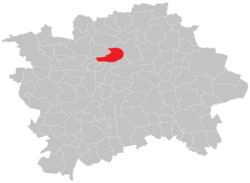Holešovice (Czech pronunciation: [ˈɦolɛʃovɪtsɛ]) is a district in the north of Prague situated on a meander of the River Vltava, which makes up the main part of the district Prague 7 (an insignificant part belongs to Prague 1).
Holešovice | |
|---|---|
Cadastral Area of Prague | |
 Prague tram on the Strossmayer Square, one of the main centres of Holešovice | |
 Location of Holešovice in Prague | |
| Coordinates: 50°06′10″N 14°26′23″E / 50.10278°N 14.43972°E | |
| Country | Czech Republic |
| Region | Prague |
| District | Prague 1, Prague 7 |
| Area | |
• Total | 4.69 km2 (1.81 sq mi) |
| Population (2021)[1] | |
• Total | 37,664 |
| • Density | 8,000/km2 (21,000/sq mi) |
| Time zone | UTC+1 (CET) |
| • Summer (DST) | UTC+2 (CEST) |
| Postal code | 110 00, 150 00 |
In the past Holešovice was a heavily industrial suburb; today it is home to the main site of the Prague's National Gallery with the Trade Fair Palace (Veletržní palác),[2] and the National Technical Museum.
In 1928, the Libeň Bridge was opened on the site of a wooden temporary bridge from 1903, and is still the longest river bridge in Prague.[3]
In 2020, The Guardian named Holešovice as one of the 10 coolest neighborhoods in Europe.[4]
Etymology
editThe name came from the family name, Holíš, (which can mean either "bald" or "beardless").[5]
Church of St. Anthony of Padua
editOn the Strossmayer Square lies neo-Gothic Church of St. Anthony of Padua. It was built between 1908 and 1911 by the architect František Mikš and built according to the model of the Týn Church on the Old Town Square. It has been protected as a permanent cultural monument since 2015.[6] On October 26, 1916, the church bells were destroyed for war efforts, with only the smallest, weighing forty kilograms and named Rafael, being preserved. After World War I, new bells were provided by Herold's Bell Company in Chomutov. During World War II, most of these bells were taken by Germany. In the 1980s, the church hung a 1918 gift from the American nation to the Czech people, the Liberty Bell, which is the only accurate replica of the original Liberty Bell in Independence Hall, Philadelphia.
Church of St. Klimenta/Clement
editThe Church of St. Klimenta/Clement on Kostelní Street is the oldest preserved church in the district. The first mentions of the church date from 1234.[7][8] It is originally Romanesque, and later it received a Gothic reconstruction. The church is a cultural monument of the Czech Republic[9] and has been registered as a permanent cultural monument since 1964.[10]
DOX Centre for Contemporary Art
editThe DOX Centre for Contemporary Art[11] is a multifunctional space focused on the presentation of contemporary art, architecture and design. It was created by the reconstruction of a former factory and was opened in 2008.[12] The reconstruction of the old factory into a multifunctional space is the work of architect Ivan Kroupa. In 2008, the DOX Centre for Contemporary Art was nominated for the European Union Prize for Contemporary Architecture[13] It is most known for its large rooftop sculpture/event center, Gulliver Airship, created by Martin Rajniš in 2016.[14][15] The wood and steel body of the airship itself, which visitors can walk through, connects two roof terraces that have different heights.
Demographics
edit
|
|
| ||||||||||||||||||||||||||||||||||||||||||||||||||||||
| Source: Censuses[16][1] | ||||||||||||||||||||||||||||||||||||||||||||||||||||||||
Transport
editThere are two metro stops in Holešovice, both on the C line – Vltavská and Nádraží Holešovice, which is connected with one of the largest railway stations in Prague of the same name. This district is also crossed with many tram and bus stops. This district is considered one of the most bike-friendly districts in the whole city, having many bike lanes a bikeways.
References
edit- ^ a b "Results of the 2021 Census - Open data". Public Database (in Czech). Czech Statistical Office. 2021-03-27.
- ^ "Designblok marks 25 years – and returns to Castle". Radio Prague International. 2023-09-26. Retrieved 2024-08-28.
- ^ "Libeňský most" (in Czech). Retrieved 7 December 2014.
- ^ "10 of the coolest neighbourhoods in Europe". The Guardian. 2020-02-08. ISSN 0261-3077. Retrieved 2020-02-10.
- ^ LUTTERER, Ivan ; MAJTAN, Milan ; ŠRÁMEK, Rudolf . Geographical names of Czechoslovakia . 1st ed. Prague: Mladá fronta, 1982. 376 pp. S. 107, 108.
- ^ Prague: National Monuments Institute. Record identifier 105704
- church of St. Anthony of Padua. Memorial Catalogue.
- ^ Cizek, Hrady cz s r o Jiri. "Kostel sv. Klimenta, Praha 7-Holešovice". www.hrady.cz (in Czech). Retrieved 2024-08-28.
- ^ National Archives - Archives of the Archbishopric of Prague I., book no. 2587, Pro Memoria Ecclesia Bubensis.
- ^ "Památkový Katalog". pamatkovykatalog.cz. Retrieved 2024-08-28.
- ^ VLČEK, Pavel. Artistic monuments of Prague . Edition one. Published by Prague: Academia, 2012. Volumes pp. ISBN 9788020021076, ISBN 8020021078. OCLC 855218628 pp. 425–530.
- ^ Rail, Evan (16 May 2019). "A Guide to Prague's Buzziest Neighborhood". Wall Street Journal. Retrieved 2023-03-10.
- ^ Vidali, Roberto (2023-07-03). "Andres Serrano, Infamous Beauty at DOX Centre for Contemporary Art". Juliet Art Magazine. Retrieved 2024-08-28.
- ^ "Giant zeppelin touches down at the DOX Center in Prague". www.detail.de. Retrieved 2024-08-28.
- ^ Schuler, Timothy A. "Gulliver Lands at the Dox Centre for Contemporary Art". Architect Magazine. Retrieved 2024-08-28.
- ^ "A guide to Prague, Czech Republic's evolving capital". Travel. 2022-12-04. Retrieved 2024-08-28.
- ^ "Historický lexikon obcí České republiky 1869–2011 – Praha" (PDF) (in Czech). Czech Statistical Office. 2015-12-21.
External links
edit